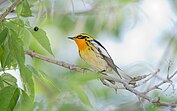Template:Did you know nominations/Anna Blackburne
- The following is an archived discussion of the DYK nomination of the article below. Please do not modify this page. Subsequent comments should be made on the appropriate discussion page (such as this nomination's talk page, the article's talk page or Wikipedia talk:Did you know), unless there is consensus to re-open the discussion at this page. No further edits should be made to this page.
The result was: promoted by Bruxton (talk) 15:33, 10 August 2023 (UTC)
| DYK toolbox |
|---|
Anna Blackburne
- ... that the Blackburnian warbler (pictured) is named after Anna Blackburne, who provided specimens to Thomas Pennant? Source: Wystrach, V. P. (July 1974). "A note on the naming of the Blackburnian warbler". Journal of the Society for the Bibliography of Natural History. 7 (1): 89–91 [1] "A critical review of the early ornithological literature shows that the dedication was made by Thomas Pennant in honor of Anna Blackburne." Easterby-Smith, Sarah (2017). Cultivating Commerce: Cultures of Botany in Britain and France, 1760–1815, p. 90: "Thomas Pennant described 158 of her zoological specimens in his Arctic Zoology (1784–85)." [2] via WP:TWL
- ALT1: ... that Anna Blackburne had a collection of 470 mounted birds? Source: Easterby-Smith, Sarah (2017). Cultivating Commerce: Cultures of Botany in Britain and France, 1760–1815, p. 87: "Anna Blackburne’s huge natural history collection consisted of a herbarium, insect and marine specimens, minerals, ores and fossils, as well as a taxidermy collection comprising 470 birds and one bat." [3] via WP:TWL
- ALT2: ... that Mrs. Blackburne never married? Source: Wystrach, V. P. (May 1977). "Anna Blackburne (1726-1793)–a neglected patroness of natural history". Journal of the Society for the Bibliography of Natural History. 8 (2), p. 150 [4]. "Mr. Blackburne did not take a second wife; neither did Anna ever marry. As early as 1771, in her first letter to Linnaeus (vide infra), she refers to herself as 'Mrs. Blackburne' in accordance with the late 18th century custom observed by maiden ladies. Thus, she stated her key position in the household rather clearly."
- Reviewed: Template:Did you know nominations/Ius civile vigilantibus scriptum est
- Comment: Expanded from 1409 B prose size to 9880 B prose size; DYKcheck for some reason doesn't acknowledge that. Better hook suggestions welcome as always.
5x expanded by Kusma (talk). Self-nominated at 20:36, 9 August 2023 (UTC). Post-promotion hook changes for this nom will be logged at Template talk:Did you know nominations/Anna Blackburne; consider watching this nomination, if it is successful, until the hook appears on the Main Page.
 Hi Kusma (talk), review follows: excellent expansion, well in excess of 5x since 9 August; sources used look reliable and are cited inline throughout; I don't have access to most of the sources but found no overly close paraphrasing in a spotcheck of ones I have access to and Earwig shows nothing worrying; hooks are all mentioned in the article, cited and check out to the extracts provided above (I double checked these in some cases where I could access the source); I had though British practice was to use "Mrs" without the full stop but I see your usage follows the sources so no quibbles from me; I quite like the whimsy of ALT2 but any could be used; a QPQ has been carried out. Looks fine to me - Dumelow (talk) 14:10, 10 August 2023 (UTC)
Hi Kusma (talk), review follows: excellent expansion, well in excess of 5x since 9 August; sources used look reliable and are cited inline throughout; I don't have access to most of the sources but found no overly close paraphrasing in a spotcheck of ones I have access to and Earwig shows nothing worrying; hooks are all mentioned in the article, cited and check out to the extracts provided above (I double checked these in some cases where I could access the source); I had though British practice was to use "Mrs" without the full stop but I see your usage follows the sources so no quibbles from me; I quite like the whimsy of ALT2 but any could be used; a QPQ has been carried out. Looks fine to me - Dumelow (talk) 14:10, 10 August 2023 (UTC)
- @Dumelow and Kusma: Her image/silhouette in the article is rather Hitchcock-ish. Bruxton (talk) 15:32, 10 August 2023 (UTC)

